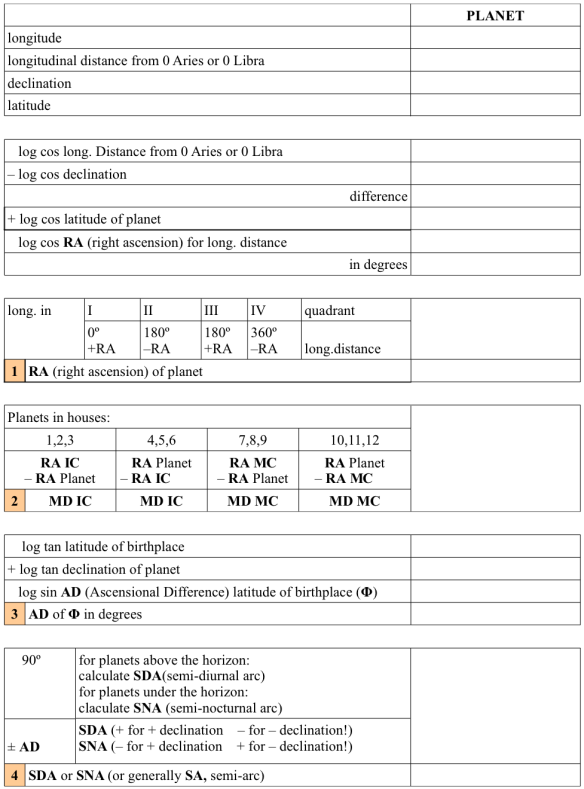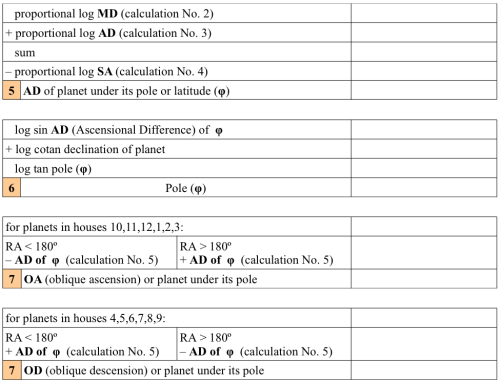Understanding primary directions seems formidable, particularly when one tries to grasp the spherical trigonometry that is needed to calculate such things as the RA (right ascension) or OA (oblique ascension) of a planet. If we try breaking the calculations down into their parts it becomes easier. What one is essentially doing is calculating unknown values from given values. What complicates matters is that we use two different co-ordinate systems to define the position of a planet on the celestial sphere. The first system uses the co-ordinates, right ascension and declination, with reference to 0 deg. Aries on the celestial equator. This is the position of the planet as seen from the earth. The second system uses the co-ordinates, longitude and latitude, with reference to 0 deg. Aries on the ecliptic, the Sun’s path. Then there is our position on earth, which are the familiar co-ordinates of geographic longitude and latitude.
If you look inside an ephemeris you will find that the longitudes, latitudes and declinations of the planets are given in universal time (GMT) for either midnight or noon. If you calculate a chart by hand you are basically adjusting this information for a particular time and location. The calculations done for primary directions are merely an extension of this. Here too adjustments are made for the particular time and location of a chart. The only difference is that the chart gives the reference points and the movements of the planets are adjusted to this (i.e. the positions in the chart are the Signifactors while the later positions are the Promissors).
Now in order to direct a planet or other important point to any position in the natal chart we need to know what its right ascension and oblique ascension is and we may even want to consider this with reference to the exact latitude of birth.
So, how do we calculate right ascension? This is where trigonometry comes into the picture. Consider the following illustration:

It is a triangle with a right angle (C). And if we define the different points and sides of the triangle in the context of our discussion. Angle A is 23,4 degrees, the inclination of the ecliptic. This means that point A is 0 degrees Aries. Side ‘b’ is a segment of the celestial equator and side ‘c’ is a segment of the ecliptic. Point B is where a planet without latitude (such as the Sun) is located and side ‘a’ is a segment of its meridian. Side ‘a’ is therefore the declination of the planet. Side ‘b’ is its right ascension and side ‘c’ its longitude. The values that we have from our ephemeris are the declination (a) and the longitude (c), we want to discover the right ascension (b). Now the sides and angles of our triangle have a whole set of mathematical relationships that describe them. These are expressed in formulae. The formula that interests us is:
cos c = cos a cos b
We have the values ‘a’ and ‘c’ so we need to rewrite this formula:
cos b = cos c / cos a, which is:
cos of RA = cos planets longitude / cos planets declination (this can be used for a planet with 0 degrees latitude, the Sun for example)
If you refer to my calculation sheet, see Calculating Primary Directions by Hand, you’ll find that this is represented by logarithms. The advantages of logarithms being that only addition and subtraction need be done instead of multiplication and division. So the formula in step 1 of the calculations is:
log cos RA = log cos longitude – log cos declination + log cos latitude.
Say our planet is at 10 Aries 00 and has a declination of 15 N 00, we would proceed by first looking up the cos logarithms for both of these values:
cos RA = 9.99335 – 9.98494 + 9.99999 (0 deg. lat) = 9.99840
RA = 4 degrees 55
From our formula we note that if the latitude of a planet is less than its declination then its RA must be smaller than its longitude. This is a check for whether our calculations are correct (not unlike checking which house the Sun is in when doing a calculation by hand. If the chart is for 11: oo in the morning there must be a mistake if it is in the 5th house!). If latitude and declination are equal then longitude and right ascension are also equal and no calculations are needed. Not that this happens often, but if one keeps an eye open it can save ten to fifteen minutes of calculation time.
What I think is really important is to understand how all of the information in the ephemeris is related to each other. If you rely entirely on your computer you may never really understand what is happening and you may not even recognise whether your software has an algorithm error.
We’ll continue looking at the calculations in a future article as I am sure this is enough to digest for the moment!


